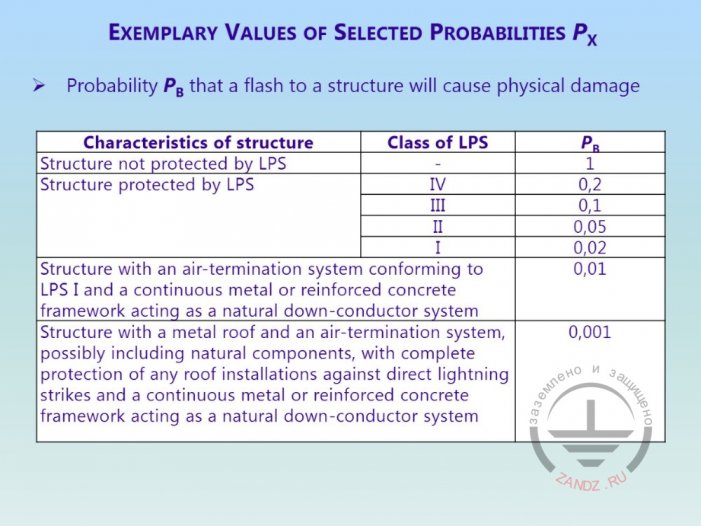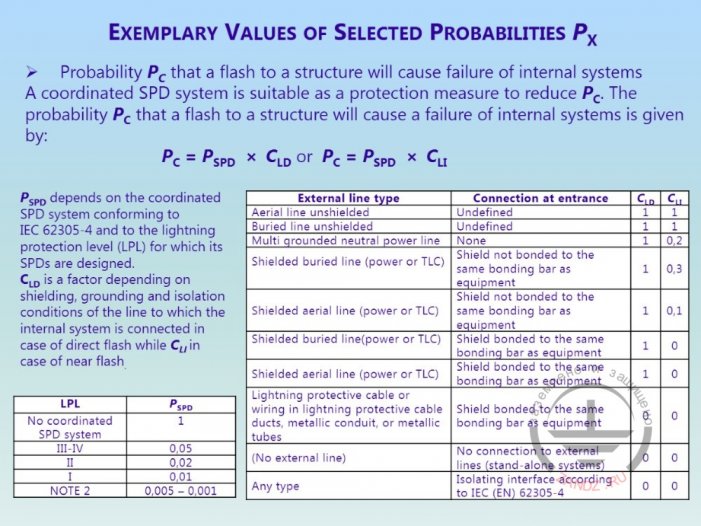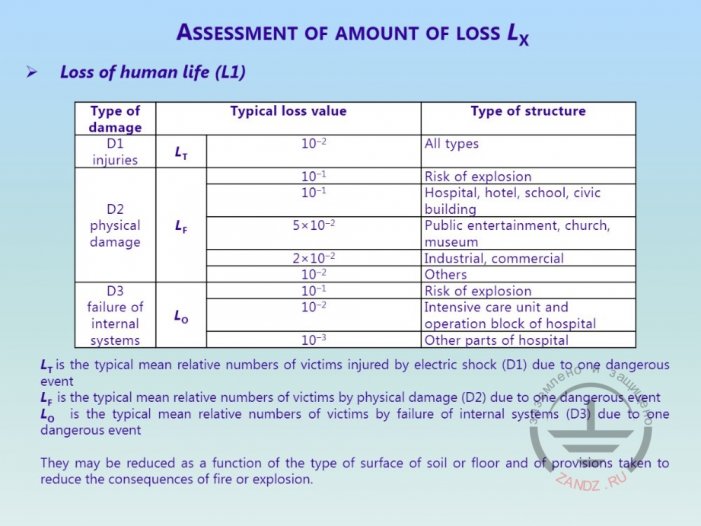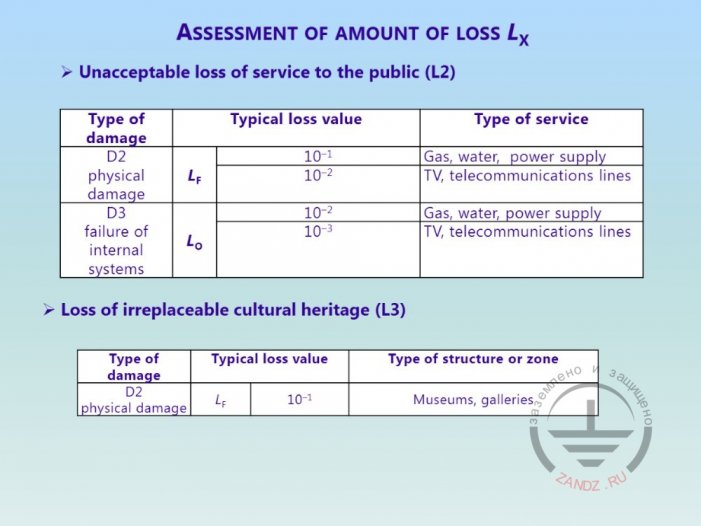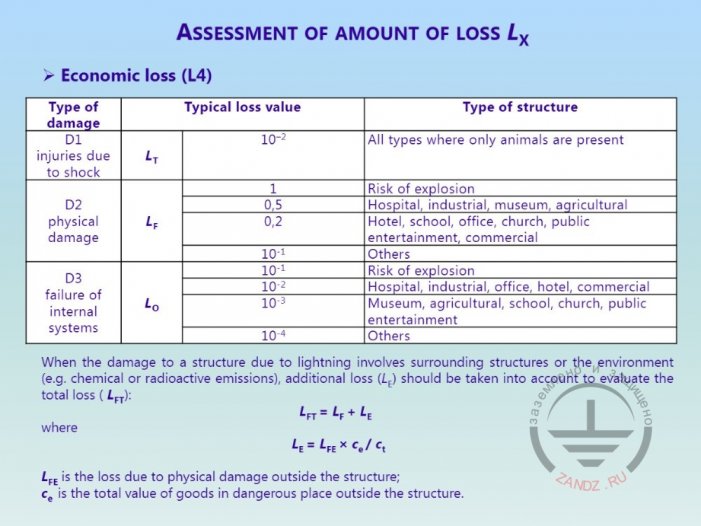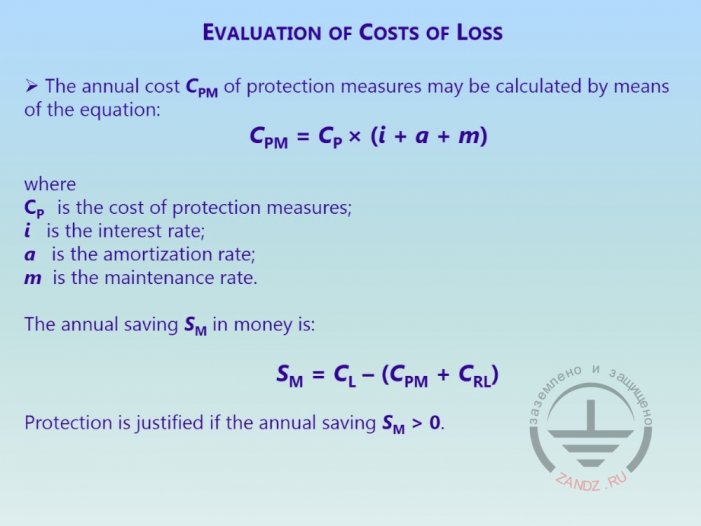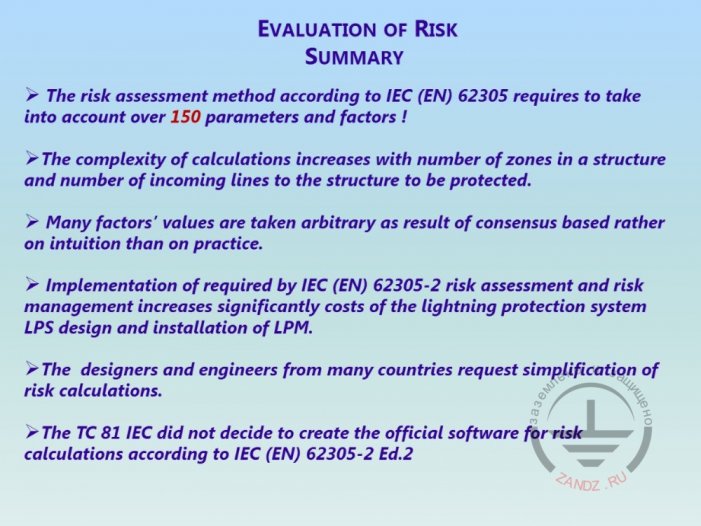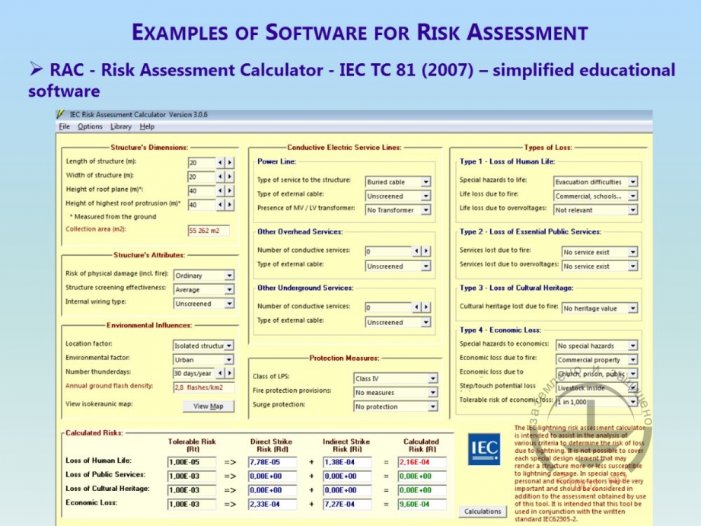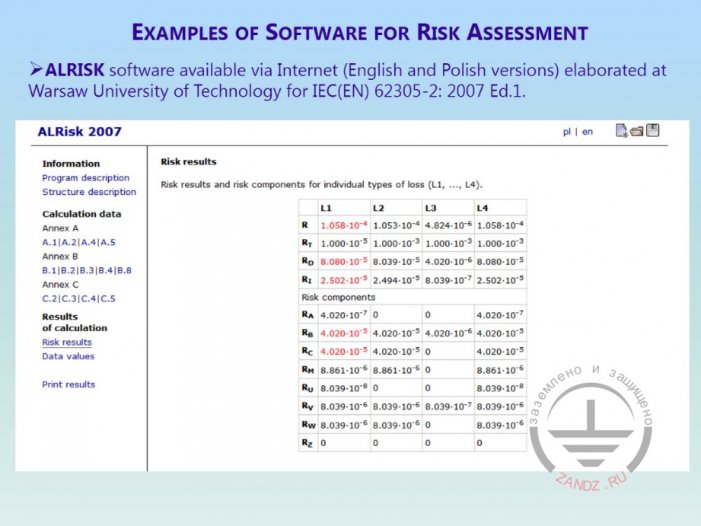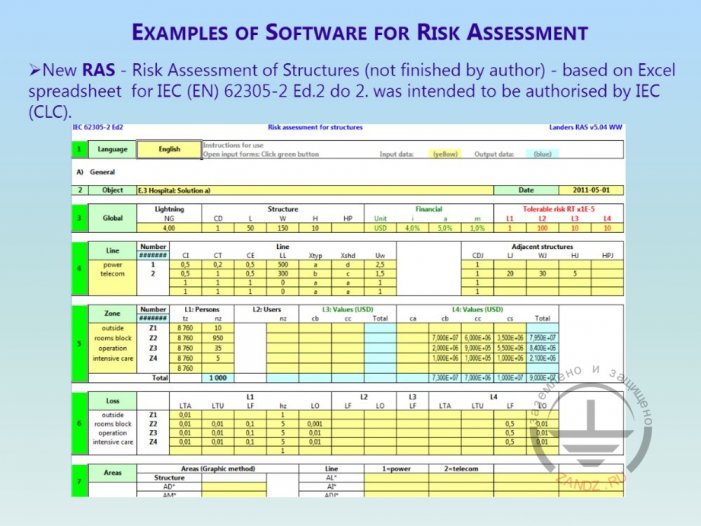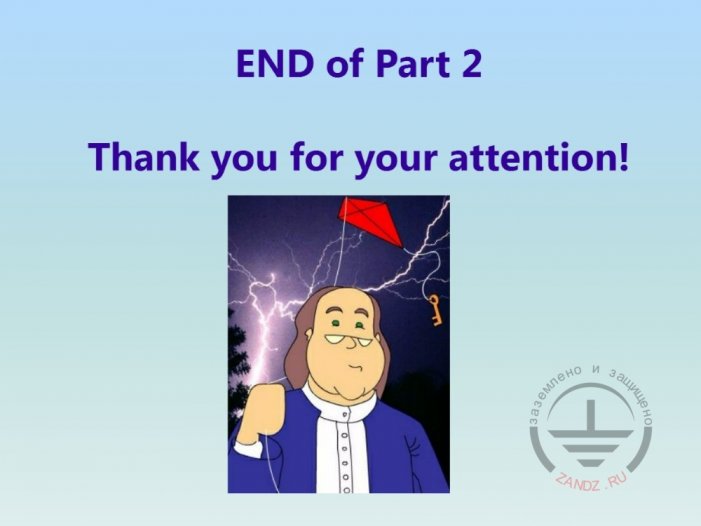The second webinar from the series "Grounding and lightning protection: International electro technical standard IEC 62305"
Webinar text. Page 3
Quick navigation through slides:
1. International electro technical standard IEC 62305
2. Configuration of IEC standards
3. Common topics and parts of the standard
4. Risk calculation
5. List of possible lightning strike points
6. Types of damage
7. Types of losses from lightning
8. Analysis of lightning risks
9. Calculation and estimation of lightning protection components
10. Individual risk components
11. Risk management
12. Methodology of risk assessment
13. Admissible risk
14. Estimation of risk components
15. Estimation of lightning strikes density
16. Map of thunderstorms
17. Charge density on the ground in a certain point
18. Density of charges around the world
19. Calculation of lightning strikes density
20. Determination of lightning strikes square
21. Calculation methods
22. IIlumination system
23. Relative position of the structure
24. Factors of impacts on the equipment
25. Estimation of damage probability
26. Approximate values of damage probability
27. Classification of lightning protection systems
28. Calculation of internal systems failure probabilities
29. Risk of mortality and injury of people
30. Estimation of damage sum
31. Economical damage
32. Estimation of losses costs
33. Summary risk estimation
34. Risk estimation program
35. ALRISK software
36. Implementation of the third version of software
37. Questions and answers
Classification of lightning protection systems
— So the idea is to estimate the risks and we will study the different probability of events. If we install lightning protection system depending on the class of this protection system. I'm going to talk about that at the third seminar. You see? Class IV, class III. It turns out so that it all reduces, but reduces in different number of times depending on the class of lightning protection system. Depending on if this protection is direct or indirect.
Calculation of probability of failures of internal systems
— There is another example here. I am not talking about the whole probability here. We need much more time for such discussions here, estimation. But I was describing all the probabilities connected with the protection here. So, for example Pc is the probability of internal systems failure and Pspd are protective devices SPDs. And systems inside the buildings, you see figures here and here. Also CD values which are connected with the direct lightning strike, in this column. And the second - indirect, that is when it is not right in the building, but at some distance near the building. All the figures connected with the installation of protective systems, coordinated and non-coordinated systems. It has a strong impact on the lightning probability.
— If you don't mind, I will read your questions, I can see them. I see 2 new questions here. I will read the first one now. "What is the efficiency of ESE lightning rods compared to traditional ones?" It is a very good question, connected with active and passive lightning protection systems. I will discuss these problems at the next webinar. I can tell that IEC 85, I am talking about International Conference on Lightning protection; the emission system was not accepted there. So if we estimate the level of protection of separate zones by a traditional or ESE method. In any case the methodology is the same according to the International Standards; it is not accepted in IEC standards yet because there are coordination systems, the so-called ES. Now we are able to use such systems, ESE systems and it is written in the IEC standards.
— «"What efficiency was demonstrated by the risk coefficients accepted in practice in Poland and other countries?". It is a very complex question, because we estimate the efficiency of lightning protection systems on the base of the methodology, which means that we reduce the probability for the equipment, installations in a correct way when we accept protective measures.
— And the third question is also connected to the structure height. «The object is of different heights: what height (H) to consider in the formula of Ad calculation- maximal, medium or minimal?» Of course, I think maximal. If you don't mind, I will show you. Let's have a look at this picture. Usually we estimate all coverage area that is all lightning. In this part of the building, if the roof is flat for example 25 m long, it is the coverage area. And for example there are 5 m or 10 m in another part. And we study different components of these areas of lightning coverage. Usually the greatest height of the building, it is better to calculate using it, because it strongly affects the size of the area touched by lightning. If we calculate coverage area, the calculation will be more precise. Do you have any more questions?
— «Please tell if it is necessary to divide the grounding devices of lightning rod and electric installation?» That is grounding and electric installation. There is a part in which it is described in detail, in the third part of the standard. I will tell you in more details at the next seminar. But I will now tell you that from the point of view of lightning protection of a building, for example, we have grounding system and lightning protection system. For the equipment, for example, if it is telecommunications. Grounding system, for example, for electric energy installation or for example power supply line. Or, for example, if you have voltage transformers, the voltage is low there. From the point of view of lightning protection, separate electrodes should be interconnected. It is much safer when we have a common grounding electronic system which will serve different parts of installations. Another question- if this approach is accepted? By other operators of these installations. And there are discussions there. From the point of view of lightning protection- of course it is better to use one. Another question?
Risk of death or injury to people
— If not, I will start the loss calculations. Separate calculation of different losses and risk components. There is a parameter - human life loss - in this chart. For all types of buildings, for typical ones. The figure is 10 in minus two. In case of a physical damage of another structure, for example church, museum, or public place. And here we also calculate parameters, you see the figures?
Damage estimation
— In any case we multiple these values. There can be an unacceptable level of loss of public services; it may be because of physical damage or due to failure in operation of internal systems. So, for example, water supply or gas supply or electric energy supplies. It is also reflected in the table. Or there are cultural heritage objects- museums or historical buildings, or galleries, such a physical damage can be also brought to them, that means destruction of these buildings.
Economic losses
— You also see figures here. And the most important thing, we see the estimation of losses here. Practical case is connected with the calculation of economic losses. Because we live in such times, when money are of a great importance. So there are three types of damage here. It is physical damage, destruction of buildings and failures of internal systems. Loss of human life.
Estimation of losses
— They are also components and in this case it is necessary to estimate the cost, that is calculate losses and annual expenditures. For example, to protective measures. It is possible to calculate and give the cost of and multiple to the components; it is a percent rate from the building, amortization and expenditures to the repair of the building. So we have indications how to support the system and how often to make inspection, how to update the system and how to estimate the quality of the electric system, electro supply and protection level. The economy is annual, the figures are very important here. If we look at the cost of losses and at the cost of protective systems, connected with measures. So the figures of losses, if we compare them, we can justify that annual installation is greater than zero. But there is a tool for making decisions on the base of economic estimation, whether to install protection or not. Estimate the risk or not. Of course, there are many telecommunications, IT systems, low-voltage equipment in modern structures, that is why external protection is important as well as protection inside the building. We have a tool how to estimate it in figures. And the figures are of course different for different buildings, it is possible to make an individual analysis for each building and estimate the individual lightning risk.
Total risk assessment
— If we come to the end of the presentation, I would like to make final conclusions. Of course, this part may be difficult for designer, for builders. But there are parameters, constructions, which should be taken into consideration and we need to consider the number of zones, these are complex calculations. And depending on the number of zones, it gets more complex. Also the number of electric lines and installations which are connected to the structure, to the building. Also the values of many factors, which are described in this presentation, they are approximate. And of course, at the estimation it becomes clear that the difference can be 5 or 10 times, because we take approximate figures here. And in should be applied in accordance with the standard for risk estimations. So in some cases, we need to discuss the general methodology.
Risk assessment program
— And historically in the first edition it was introduced, there was a calculator of risk assessment, with the help of software. And those who worked on the first part of IEC standard, could get this software version. I have a version for installation. If somebody wants to get this software, please write me an email, I will repeat the address. So I can provide you a very simple system.
ALRISK software
— One of my diploma students at the university was working on the first edition of this software. He was working on ALRISK. The software is called ALRISK. And it is in English, you can use an English version if it is ok for you. But I talked about the second edition, which changed in some places; I can give it to you too. You will contact me; I will need to update the list of potential users of this system.
Implementation of the third version of software
— And you can make calculations now, using this software. At the present day, the committee is discussing the new software, it will be version three. And professor Landres from Germany who used Excel sheets for this purpose. But unfortunately professor Landres passed away and he did not finish his calculations, still, we are finishing the software after him. The idea is to introduce an official standard. It will be third edition of IEC 62305-2 by that time. And today the solution to what level to develop, to specialize this software is taken, as well as methods of program distribution and its cost. We will discuss all that now.
Questions and answers
— It was the final part. Thank you for attention. If you have further questions, please feel free to ask me. I see there are new questions here. "How to take Lo values for a production room in which there is a certain time risk of explosion (explosive environment is present for 1 minute)?". There is an analysis in the new standard which we will surely finish. It is connected with the calculations of zones, where there is fire and explosion risk. There are supposed values for the estimation of components connected with losses. So I need to plunge deeper into the standard in order to tell you what values to take into consideration. I will come back to the chart, where L means all losses. It depends on public. It is one type of L. The lowest value should be taken here. For example, the losses which are connected with the human life loss, they need to be in minimal values indicated in the standard.
— Let me switch to another question. "Standard 62305-2 is all sufficient for all directions of use (civil and industrial objects, different branches of industry)?" There is a great variety of buildings, but there is some similarity between them. There are some installations which are connected with railway lines or are located near. There are off-shore sea installations, for example for gas and oil production. So there are some buildings, structures which are excluded from this standard. But if we talk about industrial or trade objects, buildings in different types of industry, they match this standard, it covers them.
— And the next question. "What is the operational margin of your calculations of software risks?" That's a very good question. It is connected with the software, which we developed at the university.
Do you have any questions left? Send them to our technicians and you will get detailed answers.
<< Previous Page
Slides 11 to 22
Useful materials for designers:
- Webinars with the leading industry experts
- Everything for the calculation of grounding and lightning protection
- Useful materials: articles, recommendations, examples
Related Articles:


